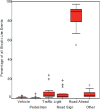Bioptic Telescope Use in Naturalistic Driving by People with Visual Impairment
- PMID: 32818098
- PMCID: PMC7396197
- DOI: 10.1167/tvst.9.4.11
Bioptic Telescope Use in Naturalistic Driving by People with Visual Impairment
Abstract
Purpose: The purpose of this study was to investigate the telescope use behaviors in natural daily driving of people with reduced visual acuity licensed to drive with a bioptic (a small spectacle-mounted telescope).
Methods: A large dataset (477 hours) of naturalistic driving was collected from 19 bioptic drivers (visual acuity 20/60 to 20/160 without the telescope). To reduce the data volume, a multiloss 50-layer deep residual neural network (ResNet-50) was used to detect potential bioptic telescope use events. Then, a total of 120 hours of selected video clips were reviewed and annotated in detail.
Results: The frequency of looking through their telescopes ranged from 4 to 308 times per hour (median: 27, interquartile range [IQR], 19-75), with each bioptic use lasting median 1.4 seconds (IQR, 1.2-1.8). Thus, participants spent only 1.6% (IQR, 0.7%-3.5%) driving time with their telescopes aiding their vision. Bioptic telescopes were used most often for checking the road ahead (84.8%), followed by looking at traffic lights (5.3%), and reading road signs (4.6%).
Conclusions: In daily driving, the bioptic drivers mostly (>98% of driving time) drove under low visual acuity conditions. The bioptic telescope was mainly used for observing road and traffic conditions in the distance for situational awareness. Only a small portion of usage was for road sign reading.
Translational relevance: This study provides new insights into how the vision rehabilitation device-bioptic telescopes are used in daily driving. The findings may be helpful for designing bioptic driving training programs.
Keywords: bioptic telescope; driver behavior; naturalistic driving; vision.
Copyright 2020 The Authors.
Conflict of interest statement
Disclosure: S. Wang, None; M. Moharrer, None; V. Baliutaviciute, None; B.E. Dougherty, None; W. Cybis, None; A.R. Bowers, None; G. Luo, None
Figures










References
-
- Marottoli RA, deLeon CFM, Glass TA, et al. .. Driving cessation and increased depressive symptoms: Prospective evidence from the New Haven EPESE. JAmGeriatrSoc. 1997; 45: 202–206. - PubMed
-
- Marottoli RA, de Leon CFM, Glass TA, Williams CS, Cooney Jr LM, Berkman LF. Consequences of driving cessation: decreased out-of-home activity levels. JGerontolBPsycholSciSocSci. 2000; 55: S334–S340. - PubMed
-
- Ragland DR, Satariano WA, MacLeod KE. Driving cessation and increased depressive symptoms. JGerontolABiolSciMedSci. 2005; 60: 399–403. - PubMed
-
- Scilley K, DeCarlo DK, Wells J, Owsley C. Vision-specific health-related quality of life in age-related maculopathy patients presenting for low vision services. Ophthalmic Epidemiol. 2004; 11: 131–146. - PubMed
Publication types
MeSH terms
Grants and funding
LinkOut - more resources
Full Text Sources

